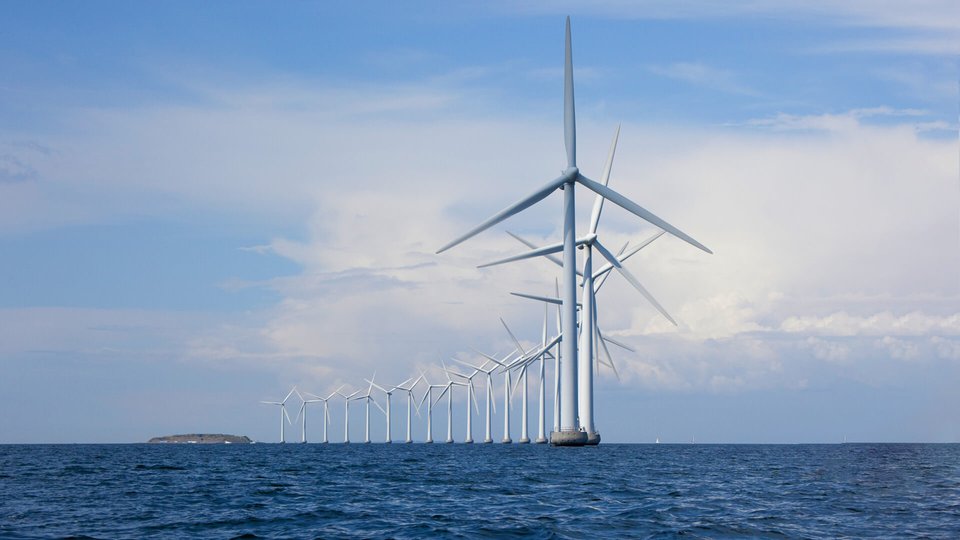The United Kingdom remains at the forefront of investment and innovation in its thriving offshore wind sector. This leadership is driven by the country’s ambitious goals and its deployment of cutting-edge technologies, making it a world leader in the offshore wind industry.
Offshore wind
The United Kingdom holds the position of the second-largest offshore wind (OSW) market globally. The British Energy Security Strategy (BESS), released in April 2022, outlines an ambitious goal to achieve up to 50 gigawatts (GW) of offshore wind capacity by 2030, with 5 GW of that coming from innovative floating technology. This ambition has the potential to generate approximately 90,000 direct and indirect jobs in the UK and forms a crucial part of the broader £100 billion private investment needed to attain the country’s net-zero emissions target.
As of now, the UK has successfully commissioned 13.9 GW of offshore wind capacity, marking a fourfold increase compared to the installed capacity in 2012. Additionally, there is a substantial project pipeline of around 77 GW spread across 80 projects at various stages, including those in construction, consented, in development, and planned for future seabed leasing auctions. This remarkable growth underscores the UK’s commitment to offshore wind and its significant role in achieving renewable energy and sustainability goals.

Commercial maturity
The UK’s offshore wind market is strengthened by a robust project pipeline and seabed lease auctions. In a recent milestone, Crown Estate Scotland awarded contracts for 27.8 GW of floating and fixed bottom wind projects in the ScotWind leasing round.
The Contracts for Difference (CfD) scheme serves as the cornerstone of the UK government’s strategy for procuring substantial volumes of clean energy at the most cost-effective rates for consumers. CfDs serve as incentives for renewable energy investment and reduce capital costs for developers by offering protection against volatile wholesale electricity prices through 15-year private law contracts. This mechanism forms the fundamental framework for offshore wind project development in the UK.
The British Energy Security Strategy (BESS) introduced the Offshore Wind Acceleration Taskforce, which concentrates on streamlining the consenting process, including planning reforms aimed at reducing approval time for new offshore wind farms from four years to one. The taskforce is also addressing the manufacturing capabilities required to meet the collective ambition of 165 GW by 2030, shared by the UK and European countries.
In line with these efforts, the Offshore Wind Sector Deal, initiated in 2019, emphasizes industry commitment to achieving 60% local content in UK offshore wind projects by 2030.
The UK government’s 2023 Spring Budget introduced a range of economy-wide capital allowance measures, which are beneficial for offshore wind projects. This includes the ability for companies to claim 100% capital allowances on plant and machinery investments until March 2026. Additionally, a 50% first-year allowance for special rate assets, including long-life assets, was introduced and will continue until March 2026.
The government is exploring the incorporation of non-price factors into the CfD auction allocation process, drawing on recommendations from the Skidmore Review and the Offshore Wind Acceleration Taskforce. A ‘call for evidence’ has been issued to gather views on whether incorporating these factors could expedite renewable energy deployment and address potential energy security concerns. If appropriate changes to the CfD scheme are identified, the government plans to consult on more detailed proposals.
Seabed Leasing Rounds
The seabed in different parts of the United Kingdom is managed by distinct entities:
- The Crown Estate is responsible for the seabed in England, Northern Ireland, and Wales.
- Crown Estate Scotland owns and manages the seabed in Scottish territorial waters and adjacent areas of the UK’s Exclusive Economic Zone.
Both of these organizations conduct periodic leasing rounds to award rights for offshore wind projects. In the most recent rounds:
- The Crown Estate awarded approximately 8 GW of capacity in Leasing Round 4.
- Crown Estate Scotland allocated rights for a substantial 27.8 GW through the ScotWind leasing round.
- The Innovation and Targeted Oil and Gas (INTOG) offshore leasing initiative awarded up to 5.5 GW for projects connected to oil and gas infrastructure or focusing on innovation and technical opportunities.
Furthermore, there are plans for the Celtic Sea floating wind leasing round, expected to occur in the summer of 2023. This initiative aims to unlock around 4 GW of new clean energy capacity in England and Wales, contributing to the establishment of a new industrial sector for the UK.
UK assets
The UK has been actively progressing its offshore wind initiatives, focusing on frequent Contracts for Difference (CfD) auctions and other developments:
Annual CfD Auctions
In February 2022, the UK government announced a shift to holding CfD auctions annually instead of biennially. This move is expected to create more opportunities for projects to enter the pipeline, thus accelerating the decarbonization of UK energy and benefiting the domestic supply chain. Allocation Round 5 was launched in March 2023, and winners are expected to be announced in the summer.
Allocation Round 4
CfD Allocation Round 4, which took place in July 2022, was a record-breaking success, securing nearly 7 GW of offshore wind capacity. The price per megawatt-hour (MWh) for offshore wind in this round was £37.35 (2012 prices), representing a nearly 70% reduction in costs since the first CfD auction in 2015. Offshore wind is now cheaper than onshore wind, solar, and tidal energy. Notable winners included projects such as Hornsea Three, Inch Cape, East Anglia Three, Norfolk Boreas, Moray West, and the first-ever CfD awarded to a floating offshore wind project, Hexicon’s TwinHub.
Celtic Sea Leasing Round
The Crown Estate has progressed its floating wind leasing initiative in the Celtic Sea, refining areas of interest. Seabed rights are anticipated to be awarded in 2023, with a goal to deliver up to 4 GW of floating offshore wind projects, providing energy for approximately 4 million homes.
ScotWind
Crown Estate Scotland’s two ScotWind leasing rounds awarded 27.6 GW across 20 projects, including a significant portion of floating wind capacity. These rounds demonstrate the UK’s ambition and Scotland’s eagerness to invest in the local economy, positioning Scotland as the world’s largest market for floating wind technology.
Innovation and Targeted Oil and Gas (INTOG) Leasing Round
Operated by Crown Estate Scotland, INTOG provides rights for building offshore wind farms that can supply low-carbon electricity to oil and gas installations, contributing to sector decarbonization. The round also supports small-scale innovation projects, including hydrogen. The exclusivity agreements for 13 projects with a total capacity of 5.499 GW were offered in March 2023.
Floating Offshore Wind Investment Scheme (FLOWMIS)
The UK government recognizes the potential of floating wind technology, which allows access to deeper seabed areas. To support its ambition of 5 GW in floating offshore wind capacity, FLOWMIS was launched in March 2023, with a value of up to £160 million. This scheme focuses on investment in port infrastructure for the deployment of large-scale floating offshore wind components. Applications for this scheme will close in June 2023, and the UK aims to strengthen its world-leading position in floating offshore wind technology.
These initiatives reflect the UK’s commitment to expanding its offshore wind capacity and enhancing its position as a global leader in renewable energy technology.
Strategic priorities for investment
The UK has identified a range of high-value manufacturing components as key strategic priorities for both fixed-bottom and floating offshore wind projects. These components are crucial for the successful development and operation of offshore wind farms and represent opportunities for innovation and economic growth. The strategic priorities include:
- Floating Substructures: These are essential for supporting offshore wind turbines in deeper waters, such as floating platforms and semi-submersibles.
- Floating Anchoring and Mooring Systems: These systems keep floating wind turbines securely in place and allow them to adjust to changing conditions.
- Blades: The design and production of wind turbine blades are critical for optimizing energy capture and efficiency.
- Monopile Foundations: Monopiles are a common foundation type for fixed-bottom offshore wind turbines, anchoring them to the seabed.
- Towers: Towers support the wind turbines and elevate them above the water’s surface to capture the wind’s energy.
- Dynamic, Export, and Inter-array Cables: Cables are vital for transmitting electricity generated by the turbines to the grid and connecting turbines within an offshore wind farm.
- Transition Pieces: These components connect the foundation and the tower, playing a role in stability and load distribution.
- Port Infrastructure: Adequate port facilities are necessary for the manufacturing, assembly, and maintenance of offshore wind components.
- Nacelle and Hub: The nacelle houses the generator, gearbox, and other critical components, while the hub connects the rotor blades to the drivetrain.
- Specialist Offshore Logistics and Installation Vessels: Specialized vessels are required for the transportation, installation, and maintenance of offshore wind turbines.
- Specialist Floating Operations and Maintenance Vessels: These vessels are specifically designed for the maintenance and servicing of floating offshore wind platforms.
- Tier Two Plus Supply Chain Manufacturing: This refers to the broader supply chain involved in the production and delivery of components, including suppliers, manufacturers, and service providers.
By designating these components as strategic priorities, the UK aims to foster innovation, boost local manufacturing, and ensure the country’s leading role in the offshore wind industry. These components play a crucial role in the successful deployment of offshore wind projects and are central to the UK’s efforts to meet its renewable energy and climate goals.
Other Significant Investment Opportunities
The UK is actively developing portside infrastructure and facilities to support various aspects of offshore wind energy, including both fixed foundation and floating offshore wind turbines. These infrastructure initiatives are crucial for the manufacturing, installation, operation, and maintenance of offshore wind projects. Here are the key aspects of portside infrastructure in the offshore wind sector:
- Infrastructure for Fixed Foundation Offshore Wind Turbines: The UK is investing in port facilities that can support the manufacturing, assembly, storage, and deployment of fixed foundation offshore wind turbines. These ports play a vital role in the production and transportation of components and turbines for fixed-bottom wind farms.
- Large-Scale Deepwater Ports for Floating Offshore Wind: Deepwater ports are being developed to accommodate the fabrication, assembly, storage, and deployment of floating offshore wind turbines. Floating wind platforms are designed for use in deeper waters, and the ports need to provide the necessary facilities and space for these projects.
- Operations and Maintenance Bases: Ports and facilities for operations and maintenance are essential for the ongoing upkeep and servicing of offshore wind turbines. These bases support regular inspections, repairs, and the overall functioning of wind farms.
- High Voltage Power Cable Manufacturing: The manufacturing of high voltage power cables is critical for the interconnection of offshore wind turbines and their integration into the national power grid. These cables transmit the electricity generated by the turbines to onshore substations.
- Offshore Transmission Owner (OFTO) Tender Rounds: OFTO assets connect offshore wind farms to the onshore transmission system. The UK conducts tender rounds to award ownership and operation rights for these assets. This process involves bidding for newly built and commissioned OFTO assets, ensuring that offshore wind energy is efficiently integrated into the grid.
There are high-potential opportunities for investment and development in this sector, particularly in regions such as Teesside, Humber, and the Cromarty and Moray Firths. These areas offer a strategic advantage due to their proximity to offshore wind projects and the presence of port infrastructure, making them attractive for offshore wind-related investments and developments.
Offshore wind farm project investment
The development and operation of offshore wind farms in the UK represent significant investment opportunities across the entire project life cycle. Here are the key stages and investment opportunities associated with offshore wind energy projects:
- Project Conception to Acquiring a Seabed Lease for Development: This initial stage involves identifying suitable offshore locations, securing seabed leases, and conducting feasibility studies. Investors can participate in the early planning and development of offshore wind projects.
- Site Development to Consent and Permitting: This phase focuses on site preparation, environmental assessments, and obtaining the necessary permits and consents. Investment opportunities exist in navigating the regulatory and permitting processes.
- Construction and Installation: This stage involves the actual construction of offshore wind turbines, foundations, and associated infrastructure. Investors can contribute capital to support the construction phase.
- Operation and Maintenance (O&M): O&M is a critical aspect of offshore wind farms. This sub-sector is expected to grow rapidly, presenting investment opportunities in the maintenance, servicing, and optimization of wind turbines.
- Decommissioning: Wind farms have a finite operational life, and decommissioning involves safely removing and disposing of turbines and infrastructure. Investors may find opportunities in managing the decommissioning process.
- Offshore Electricity Transmission (OFTO): The OFTO regime is vital for connecting offshore wind generation to the onshore grid. Investors can participate in the competitive tender process for offshore transmission assets, enabling the transmission of electricity generated by offshore wind farms.
According to the Offshore Renewable Energy Catapult, the UK’s offshore wind operations and maintenance market is expected to be the second-largest sub-sector, with a projected annual opportunity of £1.3 billion by 2030. Additionally, the OFTO regime managed by Ofgem plays a crucial role in connecting renewable wind generation to the onshore grid, with ongoing opportunities for investors.
The growth of the offshore wind sector in the UK offers diverse investment opportunities across different stages of project development and operation, making it an attractive sector for both domestic and international investors.



